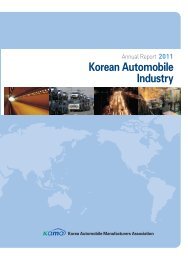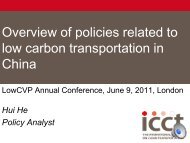Korea's Auto Industry - Today and Tomorrow - Invest Korea
Korea's Auto Industry - Today and Tomorrow - Invest Korea
Korea's Auto Industry - Today and Tomorrow - Invest Korea
Create successful ePaper yourself
Turn your PDF publications into a flip-book with our unique Google optimized e-Paper software.
<strong>Korea</strong>’s <strong>Auto</strong> <strong>Industry</strong> - <strong>Today</strong> <strong>and</strong> <strong>Tomorrow</strong><br />
Offering <strong>Invest</strong>ors a Future-Oriented Optimal <strong>Invest</strong>ment Environment<br />
Some of the features of <strong>Korea</strong> s auto parts industry<br />
First, its small <strong>and</strong> medium-centered industrial structure. The parts manufacturers<br />
directly dealing with auto manufacturers totaled 878, with 154,000 employees (as of 2003).<br />
Among them, the manufacturers categorized into large-sized companies (capital of KRW8<br />
billion or more with 300 or more employees) accounted for 7.9% or 69 manufacturers. But the<br />
number of companies with more than 1,001 employees totaled around 30.<br />
Large companies Small & medium Total<br />
Number of firms 69 (7.9%) 809 (92.1%) 878<br />
Total output of parts manufacturers directly dealing with auto manufacturers in 2003 amounted<br />
to KRW26.602 trillion. Average output per manufacturer was KRW29.68 billion. When<br />
detailing it by scale of manufacturer, the small company-group accounted for 1.9% (KRW1.8<br />
billion in an average value), medium companies 48.2% (KRW23.5 billion) <strong>and</strong> large ones<br />
49.9% (KRW188.5 billion), which clearly indicated large gaps among the companies.<br />
Second, heavy dependence on the parent company. Whereas Toyota, capable of<br />
manufacturing 7 million cars a year, had only 200 parts suppliers in 2003, Hyundai which sold<br />
1.67 million cars, had as many as 355, which means Hyundai whose output reached a mere<br />
one-fourth of Toyota, rather had far more suppliers. Of parts manufacturers, those supplying the<br />
parts to a single manufacturer accounted for 51%, heavily depending on the parent company.<br />
However, as price <strong>and</strong> quality-centered procurement practices have been taking root, the<br />
hierarchical trend is losing its power.<br />
Number of multi-transaction companies<br />
(Based on Hyundai, Kia, GM Daewoo, SsangYong, R-Samsung, Daewoo Bus)<br />
Number of parent companies to deal with<br />
1 2 3 4 5 6<br />
Total<br />
No of<br />
suppliers<br />
450 217 94 61 34 22 878<br />
% 51.3 24.7 10.7 6.9 3.9 2.5 100<br />
14 I 15 <strong>Korea</strong>’s <strong>Auto</strong> <strong>Industry</strong> - <strong>Today</strong> <strong>and</strong> <strong>Tomorrow</strong>






